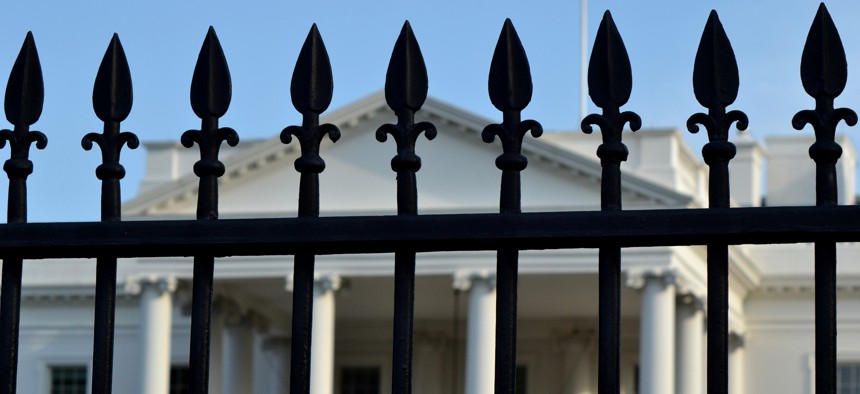Why the Next President Will Inherit a Divided Country
This election will widen the distance between the class and racial composition of each party’s core of support.
One of the driving forces of modern American politics has been the kaleidoscopic reshaping of the electorate, as minorities have steadily increased their share of the vote while whites—particularly those without advanced education—have declined. But these trends have affected the two parties in strikingly different ways, likely to further diverge in 2016.
As the first chart shows, the change in the overall electorate has been steady—and profound. Since Ronald Reagan’s landslide reelection in 1984, working-class whites—defined as those whites without a college degree—have plummeted from around three-fifths of all voters in presidential elections to just over one-third in 2012. The share of the vote cast by whites with a college degree increased from just over one-fourth in 1984 to slightly more than one-third in the 1992 election (Bill Clinton’s first victory) and has largely stabilized there since.
The next two charts track how these changes have affected each party. Using the exit polls, they calculate how much of the total vote each of these three large groups provided in 1984, 1992, 2000, and 2012 for each party’s presidential candidate. In other words, they do not measure each party’s relative performance with each group, but their relative reliance on them—capturing the role of each constituency in each party’s coalition.
The results show that Democrats have grown significantly more reliant on minority voters, while Republicans are still preponderantly dependent on support from whites—including the white working-class voters who have rapidly declined as a share of the Democratic coalition.
As the first chart shows, even as the minority share nears 30 percent of the total presidential vote, nonwhites have increased only from about 2 to 10 percent of the Republican presidential vote since 1984. That has left the GOP relying on whites for nine in 10 of their votes, even as the number of white voters fall, providing only about seven in 10 of all votes. As noncollege whites have declined in the overall electorate, they have inevitably eroded as a share of the total Republican vote as well. But, especially given their diminishing share of the overall electorate, they still constitute a significant share of the GOP electorate. As the chart shows, in 2012, whites without college degrees still provided nearly half of all Republican presidential votes even as they continued declining toward one-third of the overall vote. That gap between the GOP coalition’s share of the white vote and the entire electorate’s share was even wider than in 1984.
Put another way, the increasing tilt of white working-class voters toward the GOP blunts the impact of their overall decline in the society: They are shrinking within the Republican coalition but notably more slowly than they are as a share of the total population. Even as they have plummeted by more than 40 percent since 1984 in the total electorate, they remain the single largest group of Republican voters—and, given the pattern of Donald Trump’s support, could solidify that advantage this year.
The Democrats’ balance of power has evolved in a radically different way. From 1984 through 2012, minorities almost exactly doubled as a share of all Democratic presidential voters. In mirror-image, the working-class whites who constituted the brawny bedrock of the Democratic coalition from Franklin Roosevelt through Hubert Humphrey plummeted from just over half of all the party’s presidential voters in 1984 to only one-fourth in 2012. As with the population overall, college-educated whites increased their share of the Democratic coalition from 1984 through 1992 and have largely stabilized since.
On both sides, this year’s presidential primaries documented the impact of these changes. One key reason Trump captured the GOP nomination was his dominant performance among the noncollege whites, who remain a much larger share of the Republican than the Democratic electorate. Conversely, Hillary Clinton remains on track to claim the Democratic nomination largely because she dominated the party’s growing minority component—and also because the blue-collar whites that predominantly preferred Bernie Sanders (especially outside the South) have eroded so much as a share of the total party vote.
A Trump-Clinton general election seems guaranteed to further accelerate these shifts. Early national polls consistently show Trump amassing big margins among working-class whites but underperforming with college-educated whites and facing cavernous deficits with nonwhites. If those trends sustain, it’s possible that working-class whites could again provide nearly half of Republican presidential votes—even in an election where they may sink to only about one-third of all voters.
Conversely, behind Clinton, blue-collar whites could fall to a new low in the Democratic coalition, while minority voters march toward a new high. If Clinton slightly improves on President Obama’s 2012 performance with college-educated whites, slightly declines from his 2012 showing with noncollege whites, and largely replicates his numbers among nonwhites, the minority share of the total Democratic vote would rise closer to half, the share of college-educated whites would remain largely unchanged, and the portion of working-class whites would continue descending toward merely one-fifth.
In other words, in the most likely scenarios, this election will widen the distance between the class and racial composition of each party’s core of support. And, regardless of which side ultimately prevails, that promises to complicate the post-election challenge of finding any common ground between two coalitions embodying increasingly divergent visions of America.
( Image via Flickr user Sonara Arnav )







